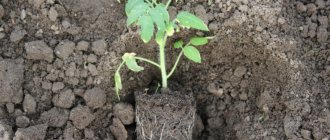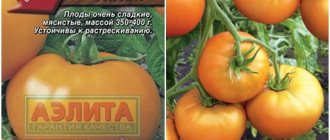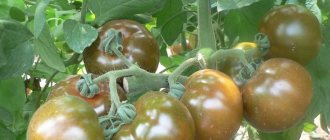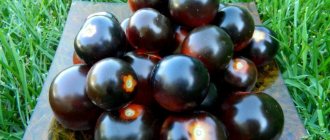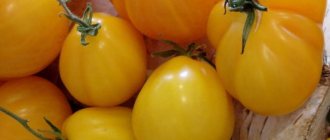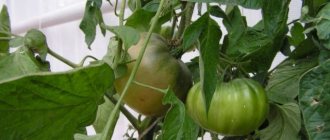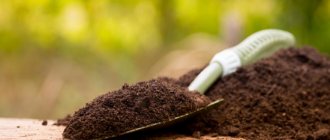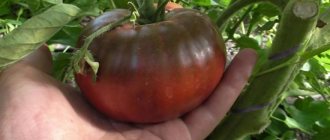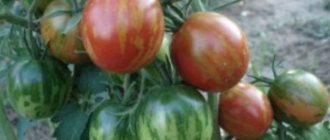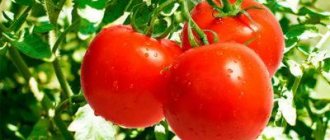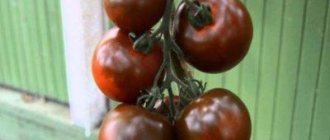Description of the handsome black De Barao
This variety was registered in the State Register in 1997. But gardeners recognized it earlier, and already the first experiments in growing the “foreigner” showed that the tomato is worthy of attention.
This is a mid-late tomato, so summer residents of the northern regions who want to get a harvest will have to work hard and create acceptable conditions for De Barao. In the south, it bears fruit well in open ground; in other areas (central Russia, North-West, Siberia) cultivation is possible only in greenhouses.
Terms – 110-120 days.
IMPORTANT! De Barao is a tall tomato, so the greenhouse for it must have the appropriate dimensions. The variety is indeterminate; in a greenhouse it can “grow” more than two meters; accordingly, it needs staking and plant formation
The variety is indeterminate; in a greenhouse it can “grow” more than two meters; accordingly, it needs staking and plant formation.
The leaf is ordinary, the inflorescence of De Barao is simple. Usually the very first brush appears above the 9th sheet, subsequent brushes appear after three sheets. Step-sonning is a must.
When grown in a greenhouse, the best results are obtained if the bush is formed into two stems (but this is at the discretion of the gardeners).
Description of the variety
Tomato "De Barao Black" is a mid-late variety. From planting seedlings in greenhouses to the appearance of the first ripe tomatoes, 115-130 days pass.
The indeterminate bush reaches a height of 2.4 to 3 meters.
The leaves are ordinary, dark green in color. The first inflorescence is laid above the 9th leaf, the subsequent ones - every three leaves. 8-9 fruits ripen in a cluster.
Main characteristics of ripe tomatoes:
- Round shape;
- Dark purple color;
REFERENCE: In the southern regions, tomatoes of the review variety can be grown in open ground.
- Weight varies from 40 to 70 grams;
- 2-3 seed chambers;
- Thin, smooth skin protects tomatoes from cracking;
- Dry matter content – 5-6%;
- Possibility of long-term storage of collected tomatoes;
- The fruits handle long-term transportation well.
Advantages and disadvantages
When talking about the pros and cons of a certain variety of vegetable crop, you need to take into account both the external and hidden qualities of the fruit and the entire plant as a whole. Now let's try to understand the advantages (and not only) of the De Barao black variety. The main advantage is the high yield compared to other varieties of tomatoes (but among “our own” there are more productive ones, for example De Barao royal or pink). Black tomatoes can withstand long-term storage without losing quality and are convenient for transportation. These tomatoes are popular among canning lovers: the small size of the fruit is ideal for rolling them into jars. When picked while still unripe, tomatoes can ripen well when stored in a warm, sunny place.
De Barao black has good immunity to diseases and is practically not affected by late blight. The plants are shade-tolerant and quite cold-resistant, so they can be grown in unheated greenhouses. But in areas with short summers, De Barao tomatoes are unlikely to be a good option for growing, since it is a mid-season variety. The fruits may simply not have time to fully ripen. Gardeners also have trouble caring for the plant, in particular, removing shoots. Disadvantages also include late planting of inflorescences.
In general, De Barao group tomatoes leave mostly positive reviews, so if you have not yet tried to grow them in your garden or summer cottage, be sure to stock up on seeds or seedlings of this variety in the near future.
Video “Growing De Barao tomatoes. Harvest"
The video shows tall De Barao tomato bushes grown along the wall. The harvested crop is shown.
Landing region
Tomatoes of the De Barao black variety are unpretentious to growing conditions, with proper care they produce a lot of fruit, however, even in the trash they will not only sprout by self-sowing, but will also produce a harvest of ripe tomatoes. True, it is small, since the bushes without proper care grow up to 50-70 centimeters. Gardeners in the south and central Russia can grow tomatoes in open ground, film shelters and greenhouses, in the north - under film and in greenhouses, and the fruits ripen during storage without compromising taste and appearance.
If there is no garden, De Barao black can be grown on the balcony. With good care, the yield will be higher than when grown in open ground.
Tomato De Barao seeds. Tomato variety De Barao
Tomatoes have long and firmly taken their place of honor in beds and vegetable gardens. One of the most popular varieties is the De Barao tomato. It was selected by Brazilian scientists in the late 90s of the 20th century. Everyone who planted this variety loved it for its excellent taste, high yield, versatility of use and resistance to diseases and pests.
Tomato variety De Barao
Varietal features
The De Barao tomato variety is indeterminate, medium-late ripening. It can reach a height of 2.5-4 m. The plant requires obligatory tying to a trellis.
The strong stems are covered with medium-sized dark green leaves. When flowering, it forms small inflorescences of simple shape. The first inflorescence appears above the 9th - 11th leaf, then every 3rd.
Up to 10 brushes are formed on the bush. The crop is grown in open and protected ground conditions. Fruits until the end of autumn.
Productivity
According to the description, the yield of De Barao tomatoes is at a high level: if the rules of agricultural technology are followed, up to 6 kg can be harvested from the bush.
When grown in open ground, fruiting is related to weather conditions at the time of fruit set, and averages 30 - 35 kg per 1 sq.m.
A more comfortable greenhouse microclimate contributes to higher yields and 40-45 kg of tomatoes are harvested from a similar area.
Application
De Barao tomatoes are small in size, average weight - 90-100 g. They have a delicate, sweetish taste, dense fleshy structure.
The fruits are ideal for fresh consumption, making salads and canning. Even when prepared for the winter, they retain their density.
Due to its fleshy structure, it is not used for the production of tomato juice.
Advantages and disadvantages
Based on the characteristics of tomatoes, the De Barao variety has many advantages and virtually no disadvantages.
The undoubted advantages include the following qualities:
- easily tolerates stress and difficult weather conditions;
- highly resistant to typical tomato diseases, in particular late blight;
- unpretentious to the planting site, bears fruit even in the shade;
- high-yielding;
- long period of fruiting, because fresh tomatoes are harvested until October, and when grown in unheated greenhouses until November;
- extremely tasty tomatoes, universal use;
- transportable, tomatoes are stored for a long time and well.
Overview of popular varieties
There are more than 10 varieties of the De Barao tomato variety, they differ in taste, size and color: the fruits can be golden, yellow, orange, striped, black, pink.
The variety has dozens of varieties
According to the description of agricultural technology, these varieties have slight differences in the process of growing, caring for and forming the plant.
- Red. Plum-shaped fruits weighing 65 - 100 g. Grows well both in the greenhouse and in the garden. With proper care, up to 6.5 kg can be removed from the bush. The fruits have excellent commercial characteristics and are suitable for canning. Resistant to diseases, withstands low temperatures well, and shade-tolerant.
- Pink. Has beautiful plum-shaped dark pink tomatoes. It takes 115 days from germination to fruit ripening. Tomatoes ripen at the same time and are resistant to diseases.
- Black. Black differs from other subspecies in the color and size of the fruit. It has a dark red-violet color and an average weight of 50 g.
- Tsarsky. A very productive subspecies. 15 - 20 kg are harvested from one plant in open ground. Cold-resistant, does not get sick and has a long fruiting period. The fruits are plum-shaped with a pointed end. Among the disadvantages is the need for regular stepsoning, because the bushes are very large, strong and require strong support.
- Giant. Red, round tomatoes that weigh on average 150 -180 g. This is the only variety that cannot be canned whole. The average yield per bush is 6 kg. This variety is grown exclusively in greenhouses.
- Tomato De Barao Golden. The main difference is the bright yellow color of the fruit; they have excellent taste and marketing properties. Partial removal of the leaf mass is necessary.
- Orange. Beautiful smooth orange tomatoes that ripen in 125 days. The average yield per bush is 12 kg. The fruits, due to the properties of the peel, tolerate the process of preservation and transportation well and do not crack.
- Kabardian. Very productive, mid-season, with fleshy, tasty tomatoes, weighing 500-700 g. The description of agricultural technology corresponds to the main type of De Barao.
- Striped. Small oval tomatoes of unusual color - yellow with red stripes. Its advantage, in addition to its original color, is its resistance to late blight.
Tomato “De Barao black”: variety description, photos and reviews
Do you know that:
“Frost-resistant” varieties of garden strawberries (more often simply “strawberries”) need shelter just as much as ordinary varieties (especially in those regions where there are snowless winters or frosts alternating with thaws). All strawberries have superficial roots. This means that without shelter they freeze to death. Sellers’ assurances that strawberries are “frost-resistant,” “winter-hardy,” “tolerates frosts down to −35 ℃,” etc. are deception. Gardeners must remember that no one has yet managed to change the root system of strawberries.
It is believed that some vegetables and fruits (cucumbers, stem celery, all varieties of cabbage, peppers, apples) have “negative calorie content,” that is, more calories are consumed during digestion than they contain. In fact, only 10-20% of the calories received from food are consumed in the digestive process.
Convenient Android applications have been developed to help gardeners and gardeners. First of all, these are sowing (lunar, flower, etc.) calendars, thematic magazines, and collections of useful tips. With their help, you can choose a day favorable for planting each type of plant, determine the timing of their ripening and harvest on time.
Oklahoma farmer Carl Burns developed an unusual variety of multi-colored corn called Rainbow Corn. The grains on each cob are of different colors and shades: brown, pink, purple, blue, green, etc. This result was achieved through many years of selecting the most colored ordinary varieties and crossing them.
In Australia, scientists have begun experiments in cloning several varieties of grapes grown in cold regions. Climate warming, which is predicted for the next 50 years, will lead to their disappearance. Australian varieties have excellent characteristics for winemaking and are not susceptible to diseases common in Europe and America.
Both humus and compost are rightfully the basis of organic farming. Their presence in the soil significantly increases the yield and improves the taste of vegetables and fruits. They are very similar in properties and appearance, but they should not be confused. Humus is rotted manure or bird droppings. Compost is rotted organic remains of various origins (spoiled food from the kitchen, tops, weeds, thin twigs). Humus is considered a higher quality fertilizer; compost is more accessible.
One of the most convenient methods for preparing a harvest of vegetables, fruits and berries is freezing. Some believe that freezing causes the nutritional and health benefits of plant foods to be lost. As a result of the research, scientists have found that there is practically no decrease in nutritional value when frozen.
From varietal tomatoes you can get “your own” seeds for sowing next year (if you really like the variety). But it is useless to do this with hybrids: you will get seeds, but they will carry the hereditary material not of the plant from which they were taken, but of its numerous “ancestors”.
In little Denmark, any piece of land is a very expensive pleasure. Therefore, local gardeners have adapted to growing fresh vegetables in buckets, large bags, and foam boxes filled with a special earthen mixture. Such agrotechnical methods make it possible to obtain a harvest even at home.
The procedure for growing tomatoes in a greenhouse
This is a wonderful type of tomato, which in greenhouse conditions can produce a maximum yield of beautiful tomatoes.
Preparation of material for planting
Seeds should be prepared for planting. First of all, they are checked for germination. To do this, dilute a teaspoon of salt in a glass of water and stir it thoroughly in the water. The seeds are dipped into this saline solution and those that float to the surface are not suitable for further germination, since there is no life in them. The remaining seeds must be disinfected and to do this they are dipped in a pink solution of potassium manganese for half an hour. Only after these procedures do they begin to plant seeds.
Testing tomato seeds for germination
When to plant
To sow in a greenhouse, seeds are sown in prepared containers at the end of February. To get good seedlings at the exit, you should adhere to certain rules:
- The container should be about 12 cm high and have drainage holes to drain excess water after watering.
- The soil for growing seedlings must be nutritious and loose. It can be purchased at a specialized store, or you can make it yourself, taking everything in equal parts - peat, garden soil, soil from a compost heap.
- The seeds are planted to a depth of 1.5-2 cm, after which they are covered with glass and wait 3-6 days for germination.
- When most of the seedlings are already above the soil surface, the glass is removed and the seedlings are grown, watering and turning them with different sides in relation to the sun.
Tomato seedlings
- I pick the seedlings when the sprouts have two true leaves and transfer them to 500 grams. cups.
Basic care requirements
This is a prerequisite for cultivating tomatoes. They are done weekly and with warm water to avoid rotting of the root mass. It is better to water in the evening so that the plant has time to become saturated with water overnight.
The first feeding of the bush is provided 10 days after planting the seedlings - fed with nitrogen fertilizers. The second is applied at the time of bud formation; it should be a phosphorus-potassium supplement and preferably in a liquid state. You should not overfeed tomatoes, as this will have a bad effect on the quality of the tomatoes.
When and how to harvest
The fruits of De Barao begin to ripen 4 months after the seedlings emerge. Fruiting is long lasting and stops only when the temperature drops to minus. Tomatoes can be picked at milk stage, and they will reach normal ripeness when ripened.
Advantages of "de barao"
This tomato is good, first of all, because “de barao” is incredibly easy to adapt to the conditions in which it is grown. Of course, residents of the middle zone and northern regions are recommended to grow this tomato in greenhouses, but this does not prevent it from being a leader among its relatives. What is the reason?
- Stable and high yield: can reach up to 40 kg per square meter.
- Versatility: its fruits are good both fresh and salted, pickled, and dried.
- Presentable: the tomatoes are almost identical, smooth, with thick skin, which allows them to retain their presentation for longer.
- Durability: thanks to the skin, tomatoes are easy to handle and transport.
- Unpretentiousness: easily bears fruit in low amounts of light, stress- and cold-resistant.
- Storage duration: can be kept “in stock” for up to two months.
- Ability to ripen: when harvesting ahead of schedule, it is enough to put “de barao” in a warm place where the tomatoes will ripen and at the same time retain their taste.
How to choose a tomato variety for seedlings: tips
Growing De Barao tomatoes
The care and cultivation of this hybrid differs markedly from the maintenance of conventional varieties. Seeds begin to be sown at the beginning of spring. For successful germination of seed material, you need to keep the seedlings at home and spray them periodically.
The dive is carried out after the appearance of the first pair of leaves. Now, the picked seedlings need to be periodically taken out into the fresh air so that they get used to it. When the risk of repeated frosts is minimized, then you can begin planting seedlings in open ground.
This variety is tall, so bushes should be planted at intervals of 1 meter. The interval between rows should be at least 1.1 meters. Planting seedlings should be done exclusively in the evening or in cloudy weather.
The application of fertilizers, namely superphosphate, begins 14 days after planting in the soil and the completion of the seedling adaptation period.
It is imperative to plant the De Barao tomato variety. As it develops, a large number of side shoots will appear; they must be removed in time. Formation consists in leaving 1-2 of the strongest stems. Also, for bushes it is necessary to have a strong support, to which they can be tied as they grow.
Pink and royal varieties have a well-developed root system that needs more moisture than the others. During the growing season and fruit setting, you need to water the plants well. You need to pour at least ten liter buckets of water under each bush.
The De Barao tomato variety can bear fruit for 90 days before the first frost. If you pick unripe fruits from the bush, they will be able to ripen in a room with a warm temperature.
Recently, among gardeners, growing the De Barao variety has gained quite a bit of popularity. Its detailed description and characteristics allow you to get delicious tomatoes in large quantities, while spending a minimum of time and effort on care.
Features of cultivation and storage
It is recommended to form a bush with 1-2 stems. The foliage is partially removed, leaving only the leaves that feed the plant. Soil is periodically added to the root zone. This helps root development and nutrition. Water moderately; frequent and abundant watering leads to blossom end rot and fruit cracking.
Experienced gardeners allow a larger number of side shoots, up to 7. At the same time, 6-7 are left on the main stem, and 2 brushes on the stepson stems.
Tomato De Barao black can be stored. With proper organization of storage, tomatoes will not lose their commercial quality within 2 months after harvest. Select fruits of technical ripeness, which ripen during the process.
Growing tomatoes
In most regions, the variety is grown through seedlings and planted in a greenhouse. Although in the southern regions with a long summer season, planting in open ground is also successfully practiced. "De Barao" is an unpretentious plant that successfully withstands temperature changes, lack of sunlight and flaws in agricultural technology.
How to prepare seeds?
“De Barao Tsarskiy” is a varietal tomato that produces excellent seedlings in the second and subsequent generations. However, self-collected seeds (as well as those purchased in a special store) require complete pre-sowing treatment. It consists of the following stages:
- Seed sorting (for self-collected ones). It is necessary to discard empty and damaged seeds, as well as seeds with traces of mold.
- Disinfection. The seeds are collected in gauze and dipped in a solution of potassium permanganate or hydrogen peroxide for 15-20 minutes.
- Growth stimulation. The seed material is soaked in solutions of the preparations “Effekton”, “Kornevin”, “Epin-Extra” for 6-12 hours.
- Bubble warm water with oxygen (for example, using an aquarium pump) for 24 hours before planting.
REFERENCE: Pre-sowing treatment increases germination by 50% and yield by 20-30%.
Sowing seed material
The soil for sowing should be loose, but contain a sufficient amount of nutrients. To 2 parts of turf add 2 parts of peat, 1 part of sand and 0.5 parts of vermicompost. If possible, it is advisable to add a little perlite and vermiculite.
A wooden box with a side of 7 cm is used as a container. The seeds are planted 2 cm into the ground using the square-cluster method with an interval of 2 cm. After watering with warm water, the box is covered with film or glass and left until germination.
After pipping the sprouts, the film is removed and cultivation continues in a room that meets the criteria:
- Air temperature – 20-24*C;
- Lighting – 12-16 hours a day (if necessary, LED lamps can be installed).
Seedlings must be periodically watered with warm water and fed with complex preparations every 20 days. The picking is carried out after the deployment of the 3rd true leaf.
Rules for planting seedlings
Planting in a permanent place is carried out 50-60 days after sowing, but not earlier than the 3rd decade of April.
Recommended landing pattern:
- Row spacing – 70 cm;
- The distance between bushes is 70 cm;
- Maximum planting density – 2 plants per 1 sq.m.
The plant is transferred to a planting hole with a large lump of earth so as not to damage the root structure. A handful of humus, peat and a tablespoon of ash are placed under each seedling.
IMPORTANT: Before transplanting plants, you need to take care of the garter system: make trellises or drive pegs into the holes so as not to have to do this later, exposing the tomatoes to additional stress.
Characteristics of the variety
First of all, it should be noted that the De Barao black tomato is an indeterminate variety, that is, the growth of this tomato bush does not stop throughout the development of the plant, due to this the height can reach 2 m or higher. In this regard, you will have to form a bush yourself, removing all the stepsons, thus leaving a single stem; pinching, accordingly, is not the most rational solution.
In most cases, this variety of tomatoes is grown in greenhouses. But in warm regions (where summer lasts longer) they practice growing such tomatoes in open ground, having previously prepared long slats for garter. Besides this, there are a couple more nuances. For planting, it is advisable to choose an area with fertile soil (even slightly shaded), but you will still have to fertilize in the future. Pay attention to their predecessors: tomatoes can be grown after cucumbers, cabbage, and legumes. The frequency of planted plants is no more than 2.5-3 pieces per 1 m2.
De Barao ripens in medium terms, approximately 115-125 days after the appearance of the first shoots. Tomato seedlings are planted in March for the first harvest to be harvested in July. The rules for caring for seedlings are the same as for most indeterminate tomato varieties. The first flower cluster is formed only when there are about 10 leaves (the next ones - after three leaves); this process cannot be accelerated in any way. The brush is simple, with 8-10 fruits. The tomatoes themselves are oval or ovoid, almost black (to be perfectly precise, dark cherry) in color, each weighing 60-80 grams. The pulp is dense and has a characteristic sweetish taste.
From one De Barao black bush you can harvest up to 5 kg of tomatoes, with super-close care - up to 8 kg. The fruits have no special purpose; they can be eaten fresh, added to salads, and used for canning.
Kinds
Different varieties of these tomatoes differ not only in the color of the peel and the taste of the pulp. Some have low yields, some are so rare that finding seeds is almost impossible. De Barao's description of tomatoes will help to more accurately understand these differences.
Orange
Small elongated fruits have a light red or bright orange color. Characteristics:
- ripening period is about 125 days;
- fruits elongated at the edges, aligned;
- yield from one bush up to 12 kg;
- bears fruit for a long time, until frost begins;
- the bush grows up to 3 m without pinching;
- record holder for carotene content, which gives the fruit its characteristic skin color;
- universal for use in cooking, suitable for both canning and adding to dishes and eating in its pure form.
The fruits of this variety have an attractive appearance. The late tall variety is grown both for sale and for personal use.
Giant
Description of the De Barao Giant tomato:
- got its name because of the weight of the fruit - on average it reaches 150 grams or more;
- the skin is dark red with a raspberry tint;
- the yield from one bush is 6 kg;
- without pruning, the stem grows 2 m or more;
- fruits are elongated, plum-shaped, the skin is dense, the pulp is sugary, sweet;
- long ripening period - at least 125 days.
De Barao Giant tomatoes are a godsend for those who want to grow a bountiful harvest in a small area. With proper organization of supports and timely pinching, the bushes bear fruit abundantly and allow you to get a lot of even, high-quality fruits from a small garden bed.
Pink
Among all tomatoes, this variety has the lowest yield and allows you to get no more than 4 kg of fruit from one bush. Grows well both in greenhouses, greenhouses, and in open ground. It has a beautiful soft pink thin skin, the pulp is juicy, sweet, the weight of one fruit does not exceed 70 g.
Tomato De Barao Pink also requires support and pinching; the bush is indeterminate and grows upward indefinitely. Ripens no earlier than 115 days from the appearance of the first shoots. Frost-resistant, shade-tolerant, yields well and is maximally resistant to major tomato diseases.
Tsarsky
It got its name for its beautiful appearance - fruits with juicy red skin, all growing about the same size, plum-shaped with a pointed tip. Characteristics:
- It bears fruit for a long time and yields a harvest - up to 20 kg in open ground from one bush;
- has high immunity against nightshade diseases;
- The shelf life of picked fruits is at least 2 months;
- frost-resistant, can grow in the shade;
- Well suited for canning, but can also be used fresh.
Due to the unlimited growth of the trunk of the De Barao Tsarsky tomato, there is a need for pinching, pinching and providing strong support for both stems and branches.
Black
Tomato De Barao Black has almost the same characteristics as other varieties. It differs in the color of the peel - at technical maturity it becomes dark purple or burgundy, and at biological maturity it acquires a black tint. The fruits are small, rarely exceed 50 g, the harvest is ready for harvesting after 115 days from the appearance of sprouts. The peel is dense, thin, the flesh is juicy and sweetish. The shape of the fruit is elongated, there is no pointed tip.
Gold
A distinctive feature of the De Barao Golden tomato is the bright yellow color of the peel. Ripening occurs within 115 days, up to 7 kg can be collected from one bush, the pulp contains a large amount of sugars and carotene. Like other varieties, it grows well in partial shade, shows consistently high fruiting, has strong immunity against major diseases, and is frost-resistant.
The shape of the fruit is plum-shaped, there is no pointed tip. All tomatoes are approximately the same size and shape, the bush bears fruit together until frost sets in.
Red
Tomato De Barao Red is the most common variety. It bears fruit later than other species, taking at least 120–130 days to ripen. The fruit weighs about 90 g, the yield from one bush reaches 4 kg. Suitable for both greenhouses and unprotected soil.
The fruits are oval, without a sharp tip, the peel is deep red, strong, thin. Excellent for canning and fresh consumption. Grows well in the shade and can withstand low temperatures.
Diseases and pests
The characteristics of the variety include a lot of advantages, including the plant’s resistance to most diseases. It is important to be able to localize the problem in a tomato garden in time: a disease that develops on one plant will eventually affect all the others, depriving the gardener of a harvest and the opportunity to plant something on the plot next season.
Black bacterial spot is most often found on tomatoes of this variety. Its first manifestations are spotty darkening on fruits, foliage and stems. Tomatoes do not ripen and lose their presentation. Affected plants must be treated with Bordeaux mixture.
Bushes that have died from the disease should be burned immediately to prevent the spread of infection throughout the area.
Blossom rot is another misfortune that can come from growing tomatoes in open ground. It appears as dark green spots on the tips of unripe fruits. Then the spots darken, and the tomato spoils and is no longer suitable for sale or home use.
():
Blossom rot is not an infectious disease, but a physiological disease caused by a lack of calcium in the tomato plant. To prevent blossom end rot, the leaves are treated with calcium nitrate twice during tomato growing: during mass flowering and when the tomato fruits are the size of a walnut.
One of the methods for preventing infectious diseases on tomatoes is mulching the soil.
Among the pests, this variety is particularly bothered by the Colorado potato beetle. The gardener needs to be prepared for the fact that these insects will have to be removed from the bushes manually, and then the plants will have to be thoroughly treated with insecticides.
Another problem with such tomatoes is slugs. They can eat the green mass of the bush and injure the fruits. They need to be dealt with using folk remedies, such as mustard tincture. 6 tbsp are diluted in 10 liters of water. l. mustard powder and the resulting solution water the space between the rows of tomatoes.
